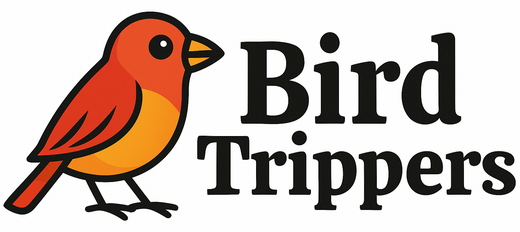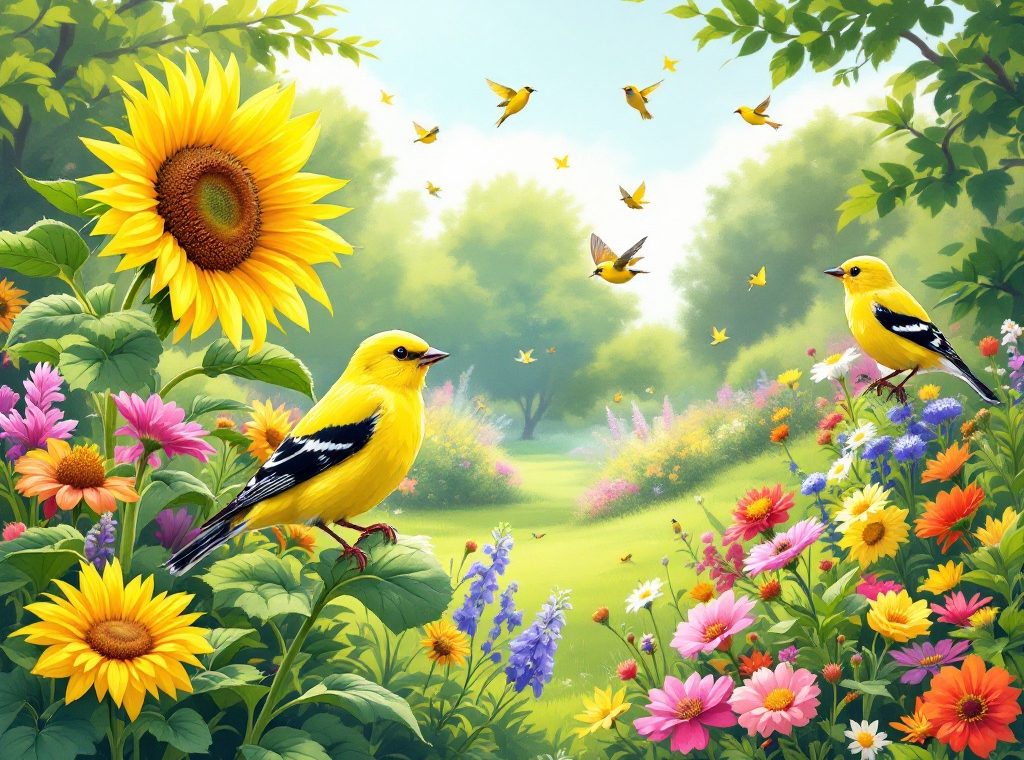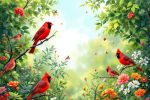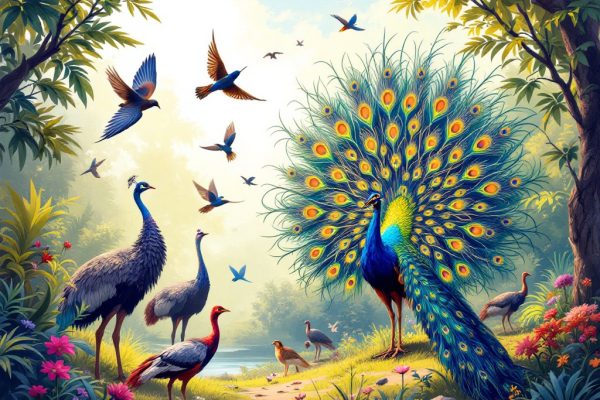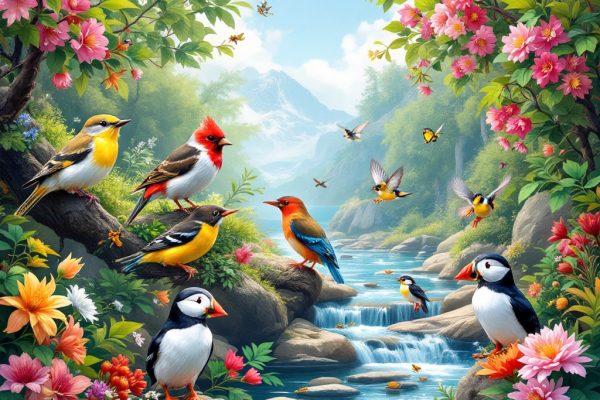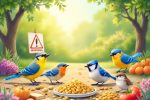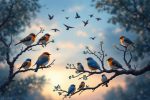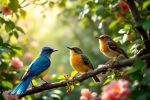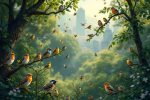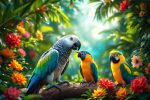Types of Yellow Birds You Can Find in America
Discover the vibrant world of North America’s yellow birds! From the cheerful American Goldfinch to the migratory Yellow Warbler, these feathered jewels add a splash of color to our landscapes. Learn about their unique characteristics, habitats, and fascinating behaviors. Explore tips on how to attract these stunning creatures to your own backyard and become a part of their vibrant world. Dive into the fascinating details of these iconic birds and enhance your birding experience!
Important information
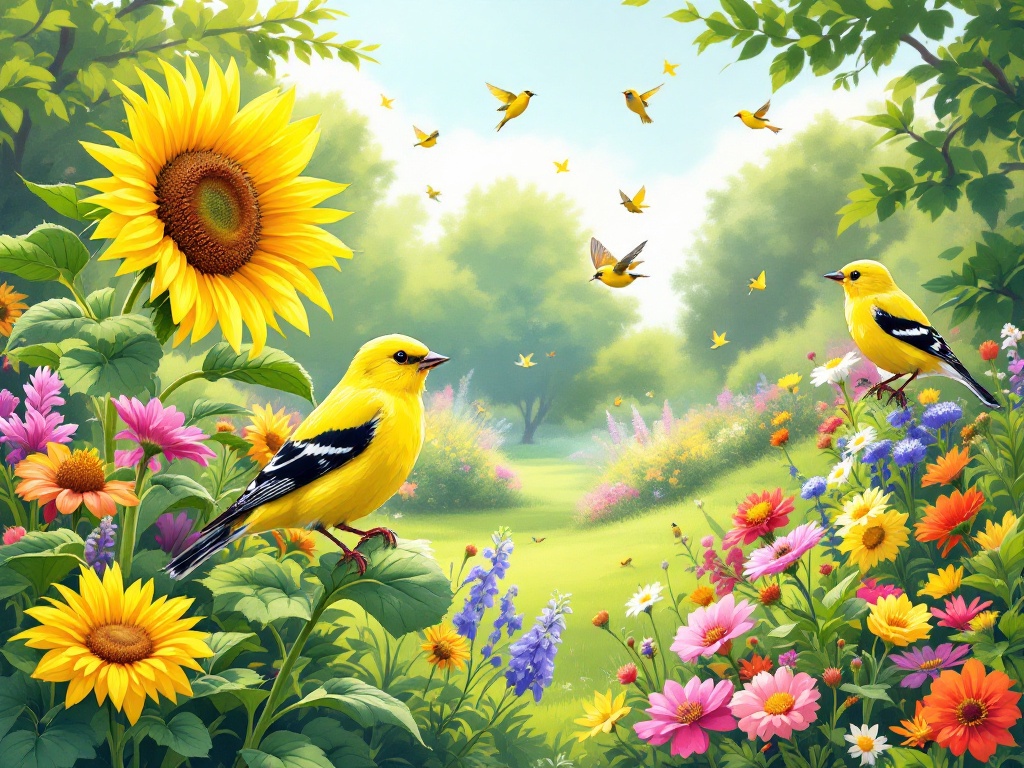
- North America hosts many yellow bird species, including American Goldfinches, Yellow Warblers, and Common Yellowthroats. These birds live in various habitats.
- Yellow birds show different colors and patterns. The shade of yellow can vary with age, sex, and season. These colors attract mates and offer camouflage.
- American Goldfinches love thistle seeds and have bright yellow breeding plumage. Yellow Warblers migrate to Central and South America for winter. Common Yellowthroats, with their black mask, stay year-round.
- Attract yellow birds to your yard with thistle and sunflower seeds, suet, native plants, fresh water, and a safe environment.
- Identify yellow birds by their markings, size, shape, and shade of yellow. Use field guides for accurate identification.
Introduction to Yellow Birds in America
North America is home to a variety of yellow bird species, each with its own unique traits and behaviors. These birds thrive in diverse habitats across the continent. Some of the most common yellow birds found in North America include:
- american goldfinch,
- yellow warbler,
- common yellowthroat.
While many of these vibrant birds, such as the American Goldfinch and Yellow Warbler, migrate south for the winter, some species, like the Common Yellowthroat, remain year-round residents.
Characteristics of Yellow Birds
Yellow birds display a stunning variety of patterns. Some, like the American Goldfinch and Yellow Warbler, are mostly yellow. Others combine yellow with black, brown, or olive markings. The shade of yellow can change depending on the bird’s age, sex, and the time of year. For example, the male American Goldfinch becomes bright yellow during breeding season. Females and winter males are a duller yellow-brown. These vibrant colors help attract mates, provide camouflage, and allow birds to recognize each other.
Habitats and Distribution
Yellow birds thrive across North America, inhabiting various environments such as grasslands, forests, and urban areas. They are commonly seen in backyards and near water sources.
Iconic Yellow Birds of North America
The American Goldfinch, a vibrant splash of yellow, is a true aerialist, flitting among thistle plants for its favorite seeds. It also enjoys other seeds.
The Yellow Warbler, a sunny traveler streaked with olive, breeds in North America and winters far south in Central and South America. Its diet is varied, consisting of insects, berries, and fruits.
Easily recognized by its black mask and namesake bright yellow throat, the Common Yellowthroat prefers the dense vegetation of wetlands, such as marshes, where it hunts insects and spiders.
American Goldfinch: The Iconic Yellow Bird
The American Goldfinch, a small North American songbird, is a vibrant splash of color. Known for its bright yellow plumage, this cheerful bird nests across the continental U.S., favoring open fields, gardens, and thistle-rich areas. Thistles provide a crucial food source. During breeding season, males become particularly striking, their yellow intensified and complemented by black wings and cap. Their distinctive conical bill adds to their unique appearance. The goldfinch’s melodious song further enhances its appeal, making it a delightful addition to any environment.
Yellow Warbler: Migratory Patterns
Yellow Warblers, known for their bright yellow feathers, breed in North America during the summer months. These tiny songbirds then migrate thousands of miles to Central and South America for the winter.
Common Yellowthroat: New World Warbler
The Common Yellowthroat, a New World warbler, inhabits wetlands and shrubby areas. This small bird is easily identified by its bright yellow throat and chest, and a distinctive black mask. Its diet consists primarily of insects, but also includes spiders and other invertebrates.
Popular Warblers and Their Features
Prothonotary Warblers are small, vibrant songbirds with bright, golden-yellow plumage. These swamp-loving birds inhabit wooded areas near water, nesting in cavities like old woodpecker holes.
The Pine Warbler, as its name suggests, prefers pine forests and enjoys a diet of insects and seeds. During winter, they frequently visit feeders.
Distinctly different, the Yellow-throated Vireo sports an olive-green back, white belly, and a striking yellow throat and breast. Two white wing bars make identification easy. These vireos favor deciduous forests and woodland edges; you might even spot one along a forest path.
Prothonotary Warbler: Small Yellow Bird
The Prothonotary Warbler, a small bird with vibrant yellow plumage, makes a striking sight in Ontario. This beautiful warbler prefers swampy woodlands and flooded bottomlands, building its nest in tree cavities near water.
Pine Warbler: Seasonal Feeder Visitor
Attracted to suet, especially in spring, the bright yellow plumage of Pine Warblers makes them easy to spot. Their pleasant songs are a bonus.
Yellow-Throated Vireo: Distinctive Markings
The Yellow-throated Vireo is easily identified by its bright yellow throat and eye ring, which are distinctive markings. These features set it apart from other vireo species.
Tanager Species and Their Habitats
Western Tanagers signal the arrival of spring in the western United States, making their nests in coniferous and mixed forests. Their eastern relatives, Summer Tanagers, bring a splash of color to backyards across the southeast, preferring open woodlands and forest edges.
Western Tanager: Springtime Sightings
Western Tanagers, with their vibrant yellow bodies and striking red-orange heads, are a welcome sight each spring.
Summer Tanager: Backyard Visitor
The small, bright yellow female Summer Tanager is a burst of sunshine. Often spotted in backyards, she searches for tasty mealworms, a welcome sight for any birder lucky enough to witness her vibrant beauty.
Blackbirds and Orioles
The yellow-headed blackbird is instantly recognizable with its bright yellow head and breast contrasting sharply against its black body. Its calls are equally distinctive – sharp and metallic.
The Baltimore oriole boasts a different palette of vibrant orange and black, accented with white. Its song is a complex melody, and its intricately woven nests are a marvel.
The tropical yellow oriole enjoys a diet of nectar, fruits, and insects, contributing to both pollination and pest control.
Yellow-Headed Blackbird: Distinctive Singer
The Yellow-Headed Blackbird, with its brilliant yellow head and distinctive song, is a striking presence along the shores of Patterson Lake. Its vibrant plumage and melodies make it easily identifiable.
Baltimore Oriole: Bright Yellow Plumage
With a flash of brilliant yellow, the Baltimore Oriole adds a vibrant splash of color to the trees it calls home. This striking bird thrives on a diet of sweet nectar and ripe fruits.
Yellow Oriole: Diet and Behavior
Attract Orioles to Your Garden with Delicious Food SourcesThe oriole, with its brilliant yellow plumage, is a striking addition to any garden. Its diverse diet makes gardens rich with food sources particularly attractive. Orioles enjoy a variety of foods, including:
- fruits,
- nectar,
- insects.
The vibrant oriole adds a welcome splash of color to any backyard.
Unique Yellow Birds
Saffron Finches are a blaze of brilliant yellow, native to the open grasslands and savannas of South America.
Yellow-Rumped Caciques prefer the forests of Central and South America, where they build remarkable communal nests and dine on fruits and insects.
Further north, in the grasslands of North and Central America, Dickcissels fill the air with their distinctive buzzing calls, sustaining themselves primarily on a diet of seeds and insects.
Saffron Finch: Habitat and Appearance
Saffron Finches thrive in open areas like grasslands, savannas, and cultivated fields. They have also adapted to urban environments and gardens. Their vibrant yellow plumage and distinctive orange-red crown make them easily identifiable.
Yellow-Rumped Cacique: Feeding Habits
The striking Yellow-rumped Cacique, with its black body and vibrant yellow rump, boasts a remarkably varied diet. This adaptable bird thrives by consuming fruits, insects, and nectar, allowing it to inhabit a wide range of habitats.
Dickcissel: Grassland Native
Dickcissels are small, colorful buntings that inhabit North American grasslands. They are easily identified by their bright yellow chests and faces.
Birding Tips for Yellow Birds
Is that a flash of yellow? Identifying your feathered friend begins with its color. Is it a vibrant, sunshine yellow, or a softer, paler hue? Check for markings like stripes, wing bars, or spots. Size and shape are also key identifiers. Consult a field guide or online resources to compare your observations and narrow down the possibilities.
Attract Birds to Your Yard
To lure these cheerful visitors, provide a varied menu:
- Sunflower and thistle seeds are always a hit.
- Suet offers a high-energy boost.
- Native flowers and shrubs provide natural foraging opportunities.
Essential Amenities
- A clean bird bath with fresh water is essential.
- Maintaining a safe feeding area will encourage return visits.
Identifying Yellow Birds by Plumage
Identifying yellow birds requires attention to detail. Observe distinct markings like stripes, spots, or wing bars. Even the shade of yellow offers clues, from the lemon-yellow of the Yellow Warbler to the golden-yellow of the American Goldfinch. The Common Yellowthroat‘s bright yellow throat and black mask make it easily identifiable. The amount of yellow also varies: the Prothonotary Warbler is almost entirely yellow, while the Yellow-rumped Warbler displays yellow patches on its rump, crown, and flanks. Consider size, shape, beak, and leg color to accurately identify the species.
Feeding and Attracting Yellow Birds
Attract vibrant yellow birds to your backyard with a diverse menu. Offer niger seeds in thistle feeders to entice American Goldfinches. Provide sunflower seeds and suet to attract other yellow beauties. Native nectar-producing flowers and seed-bearing shrubs are essential for attracting these birds. For a protein-rich treat, offer mealworms. Berries and fruits will tempt species like Yellow Warblers.
